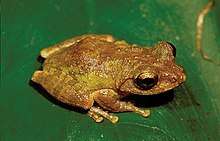Kurixalus wangi
Kurixalus wangi is a species of tree frog in the family Rhacophoridae.[2][3] It is endemic to Taiwan and occurs in the southernmost part of the island. Prior to its description in 2016, it was confused with Kurixalus eiffingeri.[1][2] The specific name wangi honors Wang Ching-Shong, a pioneering herpetologist from Taiwan.[1]
| Kurixalus wangi | |
|---|---|
 | |
| Holotype, an adult male | |
| Scientific classification | |
| Kingdom: | Animalia |
| Phylum: | Chordata |
| Class: | Amphibia |
| Order: | Anura |
| Family: | Rhacophoridae |
| Genus: | Kurixalus |
| Species: | K. wangi |
| Binomial name | |
| Kurixalus wangi Wu, Huang, Tsai, Li, Jhang, and Wu, 2016[1] | |
Taxonomy and systematics
Kurixalus wangi was described in 2016. It resembles Kurixalus eiffingeri but displays some morphological differences and a different reproductive season. Furthermore, molecular data and male advertisement call differentiate it from Kurixalus eiffingeri and Kurixalus berylliniris, its sister species. Together these three species form a lineage that is clearly separate from Kurixalus idiootocus, the fourth Kurixalus species in Taiwan.[1]
Description
Adult males measure 29–32 mm (1.1–1.3 in) and adult females 31–37 mm (1.2–1.5 in) in snout–vent length. The overall appearance is slender with flat body. The head is wider than it is long. The snout is subovoid with pointed tip in dorsal view and acuminate and slightly protruding in profile. The canthus rostralis is distinct and rounded. The tympanum is distinct, less than half of the eye diameter, with its upper margin covered by the supratympanic fold. The limbs are moderately robust. The finger and toe tips are expanded into discs. The fingers have a trace of webbing and the toes are moderately webbed. Dorsal skin is shagreened, ventral skin is slightly granular. The dorsal coloration varies from light brown with distinctly dark markings (including a dark X-like marking) to almost uniformly light green. The iris is golden-yellow.[1]
Distribution
This species occurs in southernmost Taiwan in Pingtung County.[1]
Habitat and conservation
Kurixalus wangi occurs in the shrubs of secondary forests and lowland broad-leaved forests at elevations below 500 m (1,600 ft). Eggs have been found in small pools in tree hollows and man-made structures (discarded plastic cups and plastic pipes), either above the water or submerged. The tadpoles are oophagous.[1]
As of November 2018, this species had not been included in the IUCN Red List of Threatened Species.[4]
References
- Wu, Shu-Ping; Huang, Chuan-Chin; Tsai, Chi-Li; Lin, Te-En; Jhang, Jhih-Jia & Wu, Sheng-Hai (2016). "Systematic revision of the Taiwanese genus Kurixalus members with a description of two new endemic species (Anura, Rhacophoridae)". ZooKeys. 557: 121–153. doi:10.3897/zookeys.557.6131. PMC 4740841. PMID 26877703.
- Frost, Darrel R. (2018). "Kurixalus wangi Wu, Huang, Tsai, Li, Jhang, and Wu, 2016". Amphibian Species of the World: an Online Reference. Version 6.0. American Museum of Natural History. Retrieved 28 November 2018.
- K. T. Shao (ed.). "Kurixalus wangi Wu, Huang, Tsai, Li, Jhang & Wu, 2016". Catalogue of life in Taiwan. Biodiversity Research Center, Academia Sinica, Taiwan. Retrieved 28 November 2018.
- "IUCN Red List of Threatened Species". Retrieved 28 November 2018.